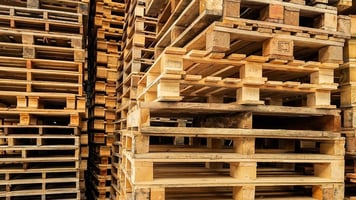When packaging durable goods or loading bulk supplies onto pallets, the last thing anyone wants is a pallet that can’t stand up to the job. Yet, most people who work with pallets regularly have experienced pallet failure. There are really only two components to a pallet: The lumber and the fasteners. Where fasteners are concerned, you can easily eliminate problems by choosing SCRAIL®, a BECK brand. Due to its aggressive thread design, SCRAIL® Nail Screw Fasteners have maximum holding power—so your pallets will stay strong. When it comes to the lumber, it’s all about wood selection. Let’s explore how to give your pallets the strength they need to hold up under any job.
Choosing the Right Lumber
If you’re experiencing lumber that breaks under the strain of the load, then you’ll need to choose better lumber. It doesn’t need to be anything fancy since pallets don’t need to be built to furniture quality standards to protect products and make it easier to move them around via forklift.
In general, look for hardwoods rather than softwoods. Oak is usually the best bet because it’s a sturdy hardwood and it’s widely available. People often find that when using oak, they can use thinner lumber and fewer boards to build sturdy pallets, which offers some cost savings—and there are often surpluses leftover from housing and furniture construction, which makes it a cost-effective choice when repurposed for pallet production.
Choosing the Right Fasteners
There are lots of different options when it comes to pallet fasteners. Some options can save you money, but they’ll increase everyone’s frustration levels. Other options are ideal for helping build a stronger pallet whether using hardwoods or softwoods. Staples, nails with plain shanks, and threaded nails are all common options—and then you have the SCRAIL® system. Let’s take a look at each:
- Staples: While cheap and easy to install via a staple gun, staples are among the worst fasteners to use in pallet construction. They’re usually made with thin-gauge wire, which means they break easier than the average nail. Worse, they feature smooth shanks, which means they’ll pull free of the wood easily.
- Smooth shank nails: Another common option, some prefer using smooth shank nails because they’re easy to drive via a nail gun. However, here again, the smooth shanks make it so that the nails can work free easily. This can lead to nail heads poking up and damaging the products sitting on the pallet. Another issue stems from overdriven nails or nails that are too long, which can also cause scratches and damage.
- Ring shank and screw shank nails: Ring shank nails are a good option for softwood species. The ring shanks offer a lot of grip when buried in softer wood. But as we earlier said, softwood is not the ideal lumber for pallets.
- The SCRAIL® System: For a number of reasons, The SCRAIL® system is going to be your best bet. SCRAIL® nail screws are adjustable and removable just like screws, and like screws or threaded nails, they have superior grip strength to hold lumber in place even under heavy loads. Combine that with the fact that they can be shot like nails, and you’ll find that pallets go together quickly and easily.
To learn more about the features of SCRAIL® fasteners, watch our video to see it in action for yourself. You’ll see how they are shot like nails, plus are easy to adjust and remove like screws.
.svg.png)


